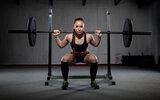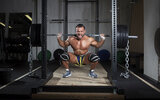01dragonslayer
Ripped
- Jacked Cash
- 479,714
Ass to grass or just below parallel? That is one of the most common questions in the gym when it comes to squatting. The depth on the ‘King of All Exercises’ is something that needs to keep being addressed, and you may be surprised to find out what our angle is.
The correct answer to that never-ending question is…both, depending on your goals. And we will show you the pros and cons of each.
If you already have an issue with your knees or back, injury prevention and maintenance must come into play since missing any time – especially an elongated period if surgery is required - will set you back a lot further than you can ever imagine. These are areas of your body that you cannot do much about once suffering an injury, and just your every day functions will aggravate them.
First things first, though. Why are you going to the gym in the first place? Are you training for a bodybuilding competition, powerlifitng meet, or just trying to stay in shape? This will determine the style that you will want to use for squats and there are good reasons why each will give you different results.
What you are looking to do is let the muscles do the work and put them in a difficult position to complete the rep. So that means you should go just below the parallel mark before coming back up for the next rep.
But let’s back it up a few steps and go over some important aspects that will help you in getting to that point. One of the most important aspects to keep in mind is foot position. Take a shoulder width stance with your toes slightly pointed outward. This will be the ideal position for you to fully engage your quads as the primary muscle worked and really hit the outer thigh. This will give you that highly-seeked teardrop look.

The bar should sit comfortably on your lower traps and you should be looking straight ahead as you begin your descent. Your knees will go out slightly in the same direction as your feet and you want to go down until you go break parallel, meaning that your hips should be just below your knees. Drive your feet into the floor as you head back up.
Make sure that you do not lean forward and a good way to ensure that doesn’t happen is to keep the front of your knees lined up with your toes, or just behind them. If you begin to notice that your knees are ahead, then that is an indication your form is off and you are too far forward.
Since you are doing squats mainly for your thighs, the ‘just-below-parallel’ is the best way to keep them fully engaged throughout the entire rep. Your secondary muscles will of course get involved, as this is a compound movement. So while your glutes, hamstrings, calves and core will also be worked, the main agenda is to hit the quads as hard as you can.
This style will result in the glutes doing a lot more work than the bodybuilder version and they will be engaged even more with the lower depth that powerlifters do. When you go far below parallel (commonly known as “ass to grass”), the glutes are taking over as the main muscle group from the quads. Powerlifters have big asses and this is the reason why.
One question may be is does a power style also build up your thighs? Of course it does, and powerlifters have legs as wide as their asses. But these guys usually have a lot to work with when they start lifting and even all of that squatting doesn’t give them detailed muscular legs, but rather just wide and strong looking ones.

All of the precautionary measures such as wearing a weightlifting belt and knee wraps will do nothing if your form is sloppy or you are using a weight that you cannot handle. How many times have you been in the gym and see someone loading up the bar with plates and doing what amounts to half reps? Probably nearly every day and they are risking injury by worrying about weight over form. Besides that, going down halfway is not giving your legs a full workout.
What will ultimately happen is that these people will try to go down lower and do a legitimate rep, but cannot handle it due to the weight. So they will get stuck in a really bad position and not be able to even get back up. This will put additional pressure on the knees and back and commonly result in injury.
If you perform squats the proper way and use a weight that you can handle, you should not have to worry about suffering an injury. Wearing a belt and wraps will help stabilize your lower back and knees, respectively.
So you should certainly take advantage of what squatting has to offer – as long as you predetermine your goals and go about them safely.
The correct answer to that never-ending question is…both, depending on your goals. And we will show you the pros and cons of each.
If you already have an issue with your knees or back, injury prevention and maintenance must come into play since missing any time – especially an elongated period if surgery is required - will set you back a lot further than you can ever imagine. These are areas of your body that you cannot do much about once suffering an injury, and just your every day functions will aggravate them.
First things first, though. Why are you going to the gym in the first place? Are you training for a bodybuilding competition, powerlifitng meet, or just trying to stay in shape? This will determine the style that you will want to use for squats and there are good reasons why each will give you different results.
Squatting For Bodybuilding Or Staying In Shape
Regardless if you have aspirations of winning a Sandow or merely looking good on the beach, your form while squatting will be basically the same. Of course, if you intend on donning the posing trunks, then the weight used and the volume of your workout will be greater, but we’ll assume that you would know that if it pertains.What you are looking to do is let the muscles do the work and put them in a difficult position to complete the rep. So that means you should go just below the parallel mark before coming back up for the next rep.
But let’s back it up a few steps and go over some important aspects that will help you in getting to that point. One of the most important aspects to keep in mind is foot position. Take a shoulder width stance with your toes slightly pointed outward. This will be the ideal position for you to fully engage your quads as the primary muscle worked and really hit the outer thigh. This will give you that highly-seeked teardrop look.

The bar should sit comfortably on your lower traps and you should be looking straight ahead as you begin your descent. Your knees will go out slightly in the same direction as your feet and you want to go down until you go break parallel, meaning that your hips should be just below your knees. Drive your feet into the floor as you head back up.
Make sure that you do not lean forward and a good way to ensure that doesn’t happen is to keep the front of your knees lined up with your toes, or just behind them. If you begin to notice that your knees are ahead, then that is an indication your form is off and you are too far forward.
Since you are doing squats mainly for your thighs, the ‘just-below-parallel’ is the best way to keep them fully engaged throughout the entire rep. Your secondary muscles will of course get involved, as this is a compound movement. So while your glutes, hamstrings, calves and core will also be worked, the main agenda is to hit the quads as hard as you can.
Squatting For Power
If you compare the way that bodybuilders and powerlifters squat, it almost appears as if they are two different exercises. The powerlifter is not concerned about anything except putting up as much weight as they can, regardless of what muscles are being worked. So they will take a completely different stance – one that is much wider and also the feet and knees pointed much further outward.This style will result in the glutes doing a lot more work than the bodybuilder version and they will be engaged even more with the lower depth that powerlifters do. When you go far below parallel (commonly known as “ass to grass”), the glutes are taking over as the main muscle group from the quads. Powerlifters have big asses and this is the reason why.
One question may be is does a power style also build up your thighs? Of course it does, and powerlifters have legs as wide as their asses. But these guys usually have a lot to work with when they start lifting and even all of that squatting doesn’t give them detailed muscular legs, but rather just wide and strong looking ones.

Squats: An Injury Waiting To Happen?
Some people have sworn off squatting because they feel that doing them will eventually result in having bad knees and a bad back. Guess what – that is one hundred percent true, but with one major caveat. Squatting with bad form will make that happen and it will not even take that long.All of the precautionary measures such as wearing a weightlifting belt and knee wraps will do nothing if your form is sloppy or you are using a weight that you cannot handle. How many times have you been in the gym and see someone loading up the bar with plates and doing what amounts to half reps? Probably nearly every day and they are risking injury by worrying about weight over form. Besides that, going down halfway is not giving your legs a full workout.
What will ultimately happen is that these people will try to go down lower and do a legitimate rep, but cannot handle it due to the weight. So they will get stuck in a really bad position and not be able to even get back up. This will put additional pressure on the knees and back and commonly result in injury.
If you perform squats the proper way and use a weight that you can handle, you should not have to worry about suffering an injury. Wearing a belt and wraps will help stabilize your lower back and knees, respectively.
So you should certainly take advantage of what squatting has to offer – as long as you predetermine your goals and go about them safely.

